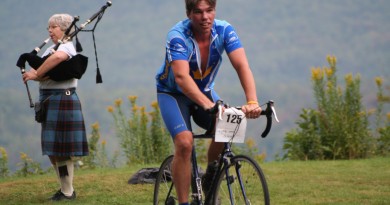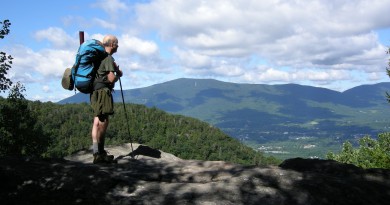More Than a Bargain | Cantons de l’Est, Quebec’s Eastern Townships, Offer Values Beyond the Buck
By Jules Older
For Vermonters in search of ski bargains, there’s a great alternative destination, and it ain’t New Hampshire. Thanks to the ever-growing disparity between the American and Canadian dollars, crossing the border is a bargain that grows every time the dollar-gap widens. Since those Yankee dollars stretch so much further, by skiing Canada instead of the United States, you can stay longer, eat better, and upgrade your lifestyle to that to which you’d like to become accustomed.
Examples? Daily lessons and nightly massages. Truffles instead of Big Macs. A hotel with Jacuzzi instead of a bunk at the Youth Hostel. Oh, yeah, and maybe pick up some new skis and boots while you’re there.
And the best news is that some Canadian areas are as accessible as many in New England; in fact, they’re just across the World’s Longest Unarmed Border.
The Eastern Townships—Cantons de l’Est—of Quebec are just waiting for you and your greenback dollar. The closest are less than an hour from the border and not much more from Burlington. While there are half a dozen or so small family hills in the Townships, four of the region’s bigger mountains would be well worth that short trip north, even without the spectacular savings.
In addition to good skiing, great instruction, and wonderful views, you’re in an exotic, foreign culture complete with tuxedoed waiters, fine wine, and menus strong on frog’s legs, rabbit stew and the regional specialty, Canard de Lac Brome. What’s more, along with French, almost everyone at the mountains and hotels speaks more than enough English to rescue you when you run out of vocabulary in the middle of a… a.. what’s the word for thought?
The Big Four of the Eastern Townships are Bromont, Sutton, Orford, and Owl’s Head. From each, you can see at least one of the others, and they’re all close enough that a four-day vacation can mean a day on each mountain plus a revisit at the end to the one you liked best. Here’s what you’ll find in this close and scenic part of La Belle Province.
While Townships skiing is big skiing by eastern Canadian standards, this isn’t Colorado or even Stowe. Bromont’s vertical drop is 1,329 feet. Orford’s and Owl’s Head’s are 1,772 feet, roughly the same as Burke Mountain minus the bottom beginners’ slopes. Sutton’s elevation is 1,500 feet, a little less than Bromley. Still, there’s a lot of skiing to be done here–and the chance of getting altitude sickness is about the same as getting scurvy.
For those looking for days of skiing and nights of urban pleasures, Bromont is the mountain closest to Montreal, about 45 minutes of fast, flat driving on Autoroute 10. Its trails overlook pancake-flat plains to the west, Lake Brome to the south, and three other Township mountains to the east. After dusk, Bromont is lit up for night skiing like a vertical Las Vegas. The lights of Montreal glow in the western sky.
It was at Bromont that I started my Townships ski-around, and at Bromont that I took my first Canadian lesson. Isabelle Emond proved to be an effective teacher, emphasizing forward stance and flowing movement. As she put it, “Skiing is like dancing. It is like the valse.”
“The valse?”
She mimed a waltz step. “It should be very fluid, and your body position is constantly changing.”
We waltzed all the way down the hill.
The next logical stop after Bromont is Sutton, a long, long ridge covered with trees and webbed with half-hidden trails. Unless you choose to wander the picturesque back roads of the region, it’s roughly half an hour’s drive from Bromont. 53 trails await you. (Orford has 52; Bromont, 23; Owl’s Head, 27.)
Though its vertical drop is less than awe-inspiring, Sutton is full of surprising steeps and long, open glades. Sutton is an old-fashioned ski hill with narrow trails, most of its trees left where nature planted them, wooden corrals to regulate liftlines and, along with one detachable quad, center-pole double chairs that look like they’re the model for a 1940’s ski poster. You can ski all day and still find trails you haven’t touched when four o’clock rolls around. Sutton is a family mountain—meaning it’s been run by one family, the Boulangers, from the day it opened.
On day three, ski Orford, the mountain that stares down on Autoroute 10, an hour east of Montreal. From the road, it looks like a true monadnock, a single peak standing alone, unsupported by a range. Up close, Orford is actually two peaks, and when the wind picks up on one, the other is usually in the protected lee. Both open on endless views. On a clear day you can see Montreal to the west and New Hampshire’s Mt. Washington in the southeast.
At Orford I took another lesson, this one with Vincent Chabert, a handsome, 40-ish instructor from Lyon, France. Vincent is a Level Four, the highest rank awarded by the Canadian Ski Instructors Alliance. He’s also something of an instructional philosopher, who began the lesson by saying, “We’ll start by feeling the snow with your feet.”
As I skied off the lift, he had me describe the snow: “Soft, thick, start-stop.”
“Does this start-stop increase your tension?” he asked.
“Well, of course.”
“And what do you do with your body when you are tense?”
“I… I pull back.”
“But to ski it well, you need to get forward, to attack it aggressively.”
Halfway down, he signalled a stop. “Now it’s time to change the up-and-down movement to sideways motion,” he said. “Instead of rising at the start of a turn, lead forward and down the hill. Ski around your body.”
And that’s exactly what I did. Suddenly the moguls were no longer determining my direction. I was! Quel breakthrough! Quel pleasure!
Spend the fourth day at Owl’s Head, a mountain so close to Lake Memphremagog that you get the feeling that one wrong turn, and you’ll be swimming to Vermont. The trails of Jay Peak are clearly visible from the summit. A monastery’s high brick tower rises from the shore. Because of the views and the casual, one-big-family ambience, Owl’s Head is a great place to relax and play in snow. Or, to continue your bargain lessons.
If you’re worried about taking ski lessons in Quebec because you’re of the mono-lingual persuasion, relax. All four areas have instructors who effectively communicate in English, and even if they didn’t, skiing is a physical sport, not a linguistic one. The best lesson I’ve ever seen was given by an Austrian in New Zealand, whose only words of English were, “Follow me.”
More info:
For information, contact Eastern Townships Tourism at 800-355-5755, www.tourisme-cantons.qc.ca or Tourism Quebec at 800-363-7777, www.tourisme.gouv.qc.ca.
Jules Older is co-winner of the North American Snowsports Journalists Award for magazine writing. His latest book is Cross-Country Skiing for Everyone.


